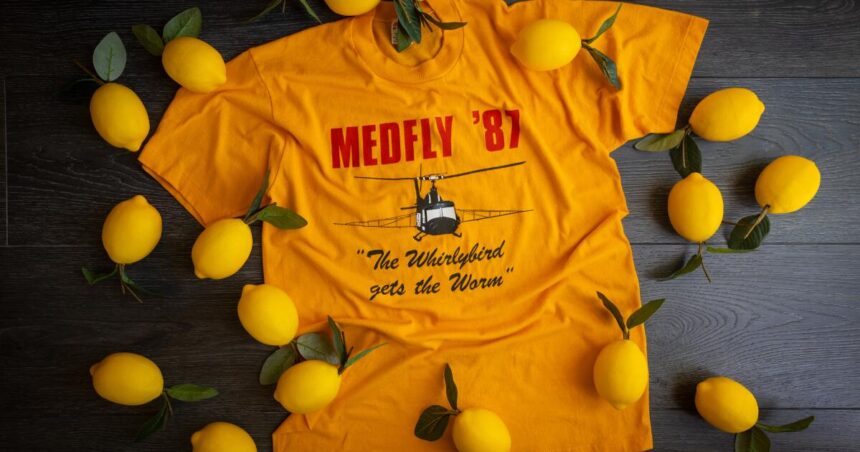In this business of ours, there are stories, and there are Stories.
Small-s stories come and go, usually as fast and forgettable as that family-sized bag of potato chips you ate all by yourself as you binge-watched the night away.
But Stories — Stories have legs, and this was a Story.
It checked all the boxes, and made some new ones: Conspiracy theories. Sex. Helicopters thwapping low over nice little neighborhoods in the dead of night. A one-legged Green Beret captain chugging a beaker of pesticide. Trippy protesters. TV comedians’ jokes. Tacky souvenirs.
And bugs.
Innumerable bugs, each one less than half the size of a housefly, but primed to chaw their way through a $16-billion California industry exactly like you did to that bag of chips.
The Story was, most of all, war — wars, plural. In the early 1980s, in the 1990s, returning like a malarial fever, the enemy was the Medfly, the Mediterranean fruit fly — pest, parasite, glutton for our golden harvests, despoiler of sunny citrus and rosy peaches, murderer of guacamole avocados.
And for most of this year, it was back. Then, in the deep-fryer depths of this summer, L.A. County agriculture officials ended a coming out of Leimert Park, along with parts of Inglewood, Hawthorne and Culver City.
Didn’t even know there was a quarantine? Well, if you’d been around here in the ‘80s and ‘90s, “Medfly” would have been all you needed to hear to know just how serious this can get.
Ninety-one degrees — way above what a new autumn day should be, even here. It’s Thursday, Sept. 25, 1975, and in a backyard citrus tree on South Glencoe Avenue in Venice, a Medfly is showing its foul face, its blue eyes and yellow belly.
For years, as an early-warning alert system, the county agricultural people had been hanging Medfly traps hither and thither among our pretty, fructiferous trees — little A-frame-shaped cardboard doohickeys with a dab of fly attractant.
This was no idle, make-work program. The Medfly, ceratitis capitata, had eaten its way through Iberia at the turn of the century, and in 1910 managed to reach Hawaii. In 1929, it rampaged through Florida’s ag business like Visigoths sacking Rome. The Medfly is not a finicky eater; its menu is as long as a Cheesecake Factory’s: 200-plus fruits and veg from every climate.
Like aliens and “Alien,” the mama Medfly makes a slit in the skin of a ripening piece of produce, lays her eggs inside, and deposits her spawn there to eat the fruit to death, from the inside out, leaving a hollow skin that plops to the ground like a zombie husk.
So when that little trap yielded its six-legged killer on Sept. 25, the county ag commissioner was not at all overreacting when he said, “I can think of no pest that sends chills down my spine like this one does.”
A few zombie fruits soon turned up nearby. It all made a good case for the Medfly having been brought in by some traveler packing a juicy souvenir.
The ag patrols jumped right on it. They laid out a quarantine map, banned commercial nurseries inside its perimeter from selling fruit trees, and stripped off what fruit they were bearing. They plucked the produce out of family gardens. They began spot-spraying with a pesticide called malathion, which was about to become a household word.
They drove around neighborhoods in trucks, fruit flies from cardboard Kentucky Fried Chicken buckets. The male Medflies were chilled to a stuporous 40 degrees, so by the time they thawed, they’d be ready for action, yet any lady Medflies they knocked up would be laying their only-once-in-a-lifetime offspring as sterile, harmless larvae.
To the massive relief of the state’s agribusiness, this outbreak and most of those to come — unlike the desolation of Florida’s commercial agriculture — were aggressively confined pretty much to small-scale commercial growers and to gentlemen cultivators with backyard trees, the kind of pocket orchards that had enticed Midwestern immigrants here with the promise that you could just step off your back porch to
And so matters stayed, uneasily but alertly, until 1980.
You say the names now — Sunnyvale, Cupertino — and they mean software and tech and billionaires in hoodies.
But for long, long decades before, Santa Clara County was “the Valley of Heart’s Delight,” a bee-and-blossom Eden of fragrant fruit: cherries, apricots, and mostly plums for prunes. Santa Clara County’s prune crop kept one-third of the world regular.
The orchards were still flourishing in 1980, during the first week of June, when bad news flew in on two wings and six legs: two small insects stuck in a backyard trap in San Jose.
The drill began anew: quarantine, fruit-stripping, ground-level pesticide spraying, more buckets of frosty male Medflies.
This time, the drill didn’t work.
California and D.C. had already begun some preliminary beat-downs over the Medfly. The new president was Ronald Reagan, and as governor, Reagan had been the Republican meat sandwiched between two California Democratic governors, Pat Brown, who had lost to Reagan, and his son, Jerry, who succeeded Reagan.
The Supreme Court had already decided that yes, indeed, Texas — which spent a hundred million buckaroos a year on California produce — could throw up its own quarantine on Golden State goods. Other states and other nations would do the same if this Medfly thing wasn’t stopped, and pronto.
As far as the feds were concerned, that meant dropping pesticide on the little buggers from the air — the same advice Brown was getting from his state ag officials.
The environmentally minded Brown argued with himself in public about whether aerial malathion spraying was the safe thing to do, and landed on “no.”
The great Medfly cafeterias of the Central Valley and the Imperial Valley, the fecund cornucopias of the nation, lay vulnerable — but arguably out of reach, Brown calculated. “Those flies,” he reasoned, “could reach Nevada a lot quicker than they could get to the Imperial Valley.”
That didn’t wash in Washington.
Unless California began aerial spraying, the feds would quarantine the entire state. And the feds threatened to take over the Medfly war themselves if Brown wouldn’t do it their way.
Politics won. Brown ordered the flying fleet aloft. The first aerial sorties went up at midnight on Bastille Day, July 14.
The public displeasure that would only swell over the next couple of years was obvious from the get-go: We don’t believe no stinkin’ studies about malathion being harmless in these doses. We’re being poisoned!
A state worker trying to send up a balloon to guide the spray helicopters had his arm slashed by a protester with a knife (it would have been smarter to slash the balloon). The state health department set up a hotline for reassurance.
Within a couple of weeks of the first spraying sorties, Palo Alto police heard what sounded like gunshots as the helicopters passed overhead. A bullet hole found in one copter had already prompted the CHP to send up an escort helicopter to accompany the flying formation of malathion sprayers.
In the meantime, the young people of the California Conservation Corps were the ones on the ground in the quarantine zone, stripping off fruit, hand-spraying with the malathion recipe. Some of them were worried, some were afraid, and some of them said they were actually sick.
And so, on the night that the aerial spraying began came what was, for my money, one of the greatest political PR moments in the history of that devilish art. There were hundreds of witnesses — but alas for the world, evidently no TV news cameras, which would never happen now, in the age of cellphone videography.
B.T. Collins headed the CCC. He was already a legendary character in an administration of outsize figures. He was a Green Beret captain and Vietnam veteran with a fake right leg and a hook as a right hand, standing in for the real ones he lost to a grenade in a Mekong Delta firefight nearly 15 years before.
He was a Republican of the Lincoln mold — honest, fearless, witty and ecumenically beloved. He had shaped this CCC into a model agency, and if his kids were worried, well, he’d do something about it.
So standing in front of a meeting of about 900 of them on that Tuesday night in the auditorium of a state mental hospital in Santa Clara, he held up a glass of the malathion recipe — and chugged it down. “I drank it because you don’t ask your troops to do anything you wouldn’t do.”
I know you are wondering, so no, he didn’t die until 1993, 13 years later, and then he was felled by a couple of massive heart attacks after long years of drinking and smoking.
As the malathion mix drifted down, so did Brown’s poll numbers. Even though he protested that his hand had been forced by the Reagan administration, ag people blamed him for not acting faster, and others blamed him for agreeing to aerial spraying at all.
The malathion-Medfly warfare illuminated a shift in the nature of California and Californians. I have a turn-of-the-century California map that describes each county by the things it grew. The figure of the woman on the state seal in one corner is Minerva, the Roman goddess of wisdom. It could just have as easily been Demeter, the Greek goddess of agriculture. By the 1980s, in counties like Santa Clara and Los Angeles, the wealth was coming more from real estate profits, not so much from agriculture. Into the 1950s, L.A. County had been the single in the nation. The new crop now was subdivisions.
The residents of this new California were urbanized people who probably felt more threatened by bug spray than by the more abstract prospect of the state’s $14-billion annual ag business being laid waste by Medflies.
Anyway, back to the early ‘80s Northern-ish California battle:
To meet the demand for irradiated, sterile male Medflies to confound the female of the species, California had ordered several million from Peru. The state pretty quickly was aghast to realize that many tens of thousands of the Peruvian Medflies weren’t sterile at all; they were fertile, horny ringers.
But when California tried to cancel its orders, the Reagan administration stepped in: California had to keep buying Peruvian bugs, it insisted, to spare Peru any diplomatic embarrassment.
The 1981 quarantine perimeter spread like a gourmand’s belt size: 450 square miles in August, to 3,100 by September. Medflies were turning up farther afield; one in the East Bay, and another in San Joaquin County, which was tantamount to seeing gold thieves approach Fort Knox with a full set of keys.
Since the Medfly can’t fly any farther than a couple of city blocks from its larval cradle, it had to be getting human help. Roadblocks and checkpoints were set up on half a dozen highways at the quarantine’s edges. Five million cars and trucks were stopped.
Somehow, something broke through the blockade, and the Medfly made its appearance hundreds of miles to the south. Which is to say, here.
On Aug. 27, 1981, the big headlines appeared too: SOUTHLAND BATTLES THE MEDFLY. In the venerable citrus belt of the San Gabriel Valley, maggots turned up in a Baldwin Park garden, eating their way through their favorite peaches, and doing the same not far away, in a pineapple guava tree.
This time, the spraying began virtually at once. No messing around. Japan, the biggest foreign market for California fruit, was already banning imports from the quarantine zone, and considering a full ban on California green goods.
The protesters weren’t messing around either. A few days after the first spraying foray, some kids clustered in a Baldwin Park parking lot and cursed the helicopters, which passed overhead in a flotilla, outnumbered by news choppers.
Caltrans ringed the now 105-square-mile quarantine zone with freeway signs: “LEAVING MEDFLY QUARANTINE AREA. NO FRUITS/VEGETABLES TO GO BEYOND THIS POINT.” This time, there was no inspection of cars leaving the zone.
Plans were afoot to hang more Medfly traps, a lot more. Until now, they’d been sparse, partly because some study suggested that Medflies couldn’t hack it in chilly weather, which turned out not to be true. So about 120,000 traps, each with a drop of lure at the bottom, and costing 17 cents each, would now be found at 100 per square mile.
Now we arrive at the stage of kitsch, which is an absolute requirement for any story to become a Story.
In 1981, Johnny Carson costumed himself as a Medfly for this exchange with sidekick Ed McMahon.
Ed McMahon: “Don’t you think the federal government should protect Florida’s fruit?”
Mediterranean Fruit Fly: “Not according to Anita Bryant, no — they shouldn’t.”
To get the joke, you need to know two things. Anita Bryant, a singer and former beauty queen, was making commercials for a brand of Florida orange juice when, in the 1970s and ‘80s, she also crusaded against gay rights and, as a forerunner to the current “grooming” madness, warned ominously about gay “recruiting.” Millions boycotted the orange juice, and Carson mocked her regularly on his show.
Second thing: “fruit” was then in pretty free use as a synonym — now it’s regarded as a slur — for a gay person.
The knick-knacks churned forth: anti-malathion spraying and anti-Jerry Brown T-shirts, buttons and bumper stickers. Also in 1981, Chris Norby, a future mayor of Fullerton, Orange County supervisor and Republican Assembly member, created “The Medfly Game” for two players — Jerry Brown and the Medfly.
As for the conspiracies, in December 1989, people calling themselves “The Breeders” wrote anonymously to newspapers, state legislators and to .
We did it, they claimed. We’re spreading around Medflies to protest the state’s agricultural policies. “Every time the copters go up to spray, we’ll go into virgin territory or old Medfly problem areas and release a minimum of several thousand blue-eyed Medflies. We are organized, patient and determined.”
In the fall of 1982, after two wearying years of quarantines that ultimately extended through six counties and some 3,000 square miles, California declared victory. The Medfly had been eradicated.
Hubris, right? Wait for it.
A year later, Jerry Brown was termed out, and the Medfly seemed to have been sprayed out.
But in 1989, there was a flare-up in Whittier. The new governor, first-term Republican George Deukmejian, had learned from Brown not to let anyone hang this buggy albatross around his neck, and left it to his ag folks to spray and protect.
The spraying created a boomlet for carwashes and the plastic sheeting trade. A woman driving her 5-day-old Nissan Maxima was caught in a malathion shower on her way home to Rowland Heights, where her equally new car cover awaited. She filed a claim for $2,754.14 ().
The most serious claim I found came from a 14-year-old Los Angeles boy named Juan Macias. On March 28, 1990, he had run outside to tell his dad to be sure to cover his truck because the spray helicopters were coming. He was hit by the malathion, his lawsuit claimed, and went blind. Five years later, the suit was still going forward.
Other kinds of pests pretty regularly turned up here and there around the state, but none as dangerous, as omniphagous, as the Medfly. That’s why counties like Los Angeles have kept up vigilant monitoring and fly-murdering programs, sometimes with new tools, to protect the state’s agricultural cordon sanitaire from Napa and Sonoma to the Mexican border.
At Christmastime in 2016, a Medfly appeared in Panorama City, and 101 square miles of the San Fernando Valley were briefly quarantined. This time, the pesticide of choice was Spinosad, an organic pesticide made from soil bacteria, not chemicals.
As for malathion, a 2000 federal review found it posed no threat to people when used correctly.
That may be fine for people. But in 2013, the feds decided that the pesticide family that includes malathion was indeed dangerous — even toxic — to many species of fish, plants, insects and animals, including the Mississippi sandhill crane and bees.
Four years later, the Trump administration asked a federal judge for a two-year delay in the pesticide review — another piece of the Trump administration’s top-to-bottom kneecapping of science and .
PBS reported that the EPA eventually threw in the towel, that malathion can imperil all manner of species, in exchange for a promise from pesticide makers to change their labels to exhort consumers to be more careful when they use it. It sounds like very weak medicine indeed.
In October 2023, the Medfly reappeared in L.A., in a . A quarantine of about 90 square miles of the city and county went into force, and nearly 2 million sterilized male Medflies, all dyed Laker-ish purple, were shoved out of planes over the nine-square-mile Medfly ground zero. This drop was to be replayed every three or four days for months. Again — not messing around.
UC Davis entomology professor James Carey, who has decades of Medfly study on his resume, told The Times: “Nowhere in the world are fruit fly invasions as frequent, recurrent, persistent, continuous, contiguous, widespread, and taxonomically diverse as those that have occurred in California.”
So we’re really left with three options on the persistence of the Medflies among us:
One, that there’s now a low-grade, permanent localized Medfly population that shows itself to us every now and then; two, that Medflies are still finding obliging humans to bring them in from places yonder; or three, that that there’s so little agriculture left hereabouts that, however they get here, Medflies just can’t find much to infest anymore.










